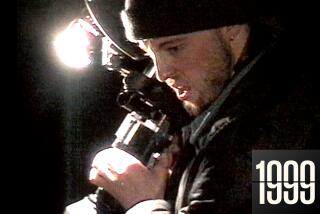Operators Are Standing By . . .
- Share via
When you hear the word “infomercial,” what do you think of? The Abflex machine? The Psychic Friends Network?
These, in fact, were both in the top 10-performing infomercials of last year, raking in well over $100 million dollars apiece in sales. Last year, infomercials did a combined total of about $840 million in business.
Now infomercial producers are eager to attract a new customer: movie studios. Theatrical releases and movie and TV videos are both envisioned as lucrative new areas of business.
At least one studio has already been doing it. Shortly before the release of the James Bond film “GoldenEye” last September, MGM/UA went out with a half-hour infomercial promoting the upcoming movie and plugging a special offer on other videos from the Bond library, all owned by MGM. Viewers could buy the first for $9.95, then collect each of the others in the set for $14.95 as they were sent one at a time to their homes. Plus, they would get “making-of-’Goldfinger’ ” and “making-of-’Thunderball’ ” tapes with their sixth video and a copy of the script for “GoldenEye” with their eighth. Now, how much would you pay?
Beth Bornhurst, MGM Home Entertainment vice president of market development, won’t disclose actual figures, but says the program was “enormously successful. . . . We absolutely achieved and exceeded our goals.”
The proof is in the production of more MGM infomercials--they’re currently running one for “Pee-wee’s Playhouse” videos that the studio says also is doing well. In October, they’ll break one for videos of “The Outer Limits” TV series, and are already in production on several more.
All the shows are done in an “Entertainment Tonight” format, luring viewers with trivia, interviews and, in the case of the “Pee-wee” infomercial, parent and kid testimonials about how much they love Pee-wee’s goofy, nonviolent brand of entertainment.
“The Bond infomercial woke the industry up. Now the Pee-wee one has proven that the format works for two entirely different genres,” says Terry Finn, president of West L.A.-based In-Finn-Ity Direct, which produced the infomercials with MGM.
Steve Dworman, publisher of the West L.A.-based Infomercial Marketing Report, and others in the industry say that all the studios are now actively looking at infomercials as a potentially powerful marketing tool.
Infomercials would seem to make perfect sense for certain kinds of pictures. Studio marketing executives are frantically looking for ways to cut through the marketing clutter to reach an audience without breaking the bank.
This summer saw 65 major film releases, up from 50 last summer. The average marketing budget for studio movies has been rising without pause in recent years, reaching more than $16 million last year.
But most studios are hesitating.
“Infomercial snobbery,” executives in the infomercial business say, is a factor. Sometimes there’s also resistance on the part of some movie stars (and their agents) toward appearing in an infomercial, even if only in footage from a film or video the studio is trying to sell.
Another reason, according to Tom Barad of Electronic Catalogue Network, or ECN, is the structure within studios that inhibits different divisions’ working together on such a project.
“Each division has its own budget, which it’s not likely willing to share with other divisions,” Barad says. “The home video division is the one where the numbers really make sense in terms of an infomercial being able to make a good profit. But I think for a theatrical release, it can really make sense even if its not a profit-making venture. If you get more people to see the movie, it drives the entire revenue stream of the picture.”
Barad left his job as senior vice president of production at Paramount three years ago to form ECN, a Santa Monica-based infomercial production company, with former Paramount president of production Gary Lucchesi.
Barad says they’ve met with executives at two or three studios several times, but so far have encountered resistance to trying infomercials. He insists, though, that “if I were an executive again today--from what I’ve learned in this business--I’d have to seriously consider infomercials as part of my advertising budget. There are just so many competing movies out there, and this can give you a better chance” at the box office.
What it also does, as with any direct response method (e.g., as with record and video clubs), is give the studio a database of consumers who have a demonstrated interest in their product. MGM’s “GoldenEye” push hasn’t stopped with last year’s infomercial: MGM did a short form, or two-minute, version of its infomercial around the time of the rental-priced video release earlier this year.
Now they’re marketing a new “Ultimate James Bond” CD-ROM by mail to customers who bought the video from the infomercials. The CD-ROM and the consumer-priced video will also both hit retail on Oct. 29.
MGM’s Bornhurst, who came to the company last year from a direct mail response background, acknowledges that video retailers may be leery of infomercials cutting into their sales. But she contends that infomercials have actually generated store sales traffic as well. “We did great with the [Bond] infomercial, and the videos also took off at retail when they were re-released later. So it was a win-win situation,” she says.
The growing emphasis on consumer products at studios may help tip the scales toward studios’ doing infomercials, particularly for ones such as Disney and Warner Bros. that have their own stores and earn larger profits on products such as apparel and toys.
There is some risk involved, of course. A good quality infomercial can easily take $500,000 or more in production costs, according to Claire Thain, vice president of marketing for Williams Television Time, an infomercial company. That doesn’t include media buys, which are increasingly pricey, particularly for prime day parts critical to a wide release such as “GoldenEye.”
In-Finn-Ity Direct and Williams Television Time are seeking to persuade Hollywood at a conference this week at the Sheraton Universal. “We’re saying: ‘Let’s pool our smarts. We think we can show you how to maximize the marketplace for your products,’ ” says Thain.
Infomercial Marketing’s Dworman says, “Why couldn’t you do an infomercial for a current theatrical release, and put up a number for one of the ticketing services like MovieFone so people could immediately reserve tickets?” Thain adds, “Fox could’ve pre-sold-out the first week of ‘Independence Day’ this way.”
Another natural: the “Star Wars” trilogy, which will get a theatrical re-release next year and that remains a huge force in video and consumer product sales. “Oh, that could be huge,” says Barad.
Oh, Mr. Luuuu-cas. . .
More to Read
The biggest entertainment stories
Get our big stories about Hollywood, film, television, music, arts, culture and more right in your inbox as soon as they publish.
You may occasionally receive promotional content from the Los Angeles Times.










